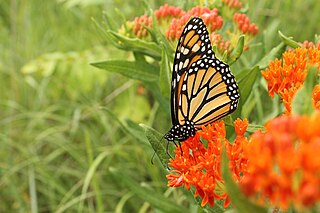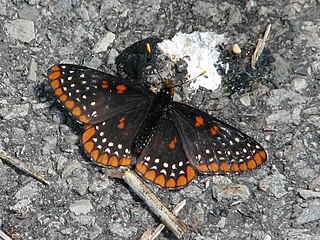
Danainae is a subfamily of the family Nymphalidae, the brush-footed butterflies. It includes the Daniadae, or milkweed butterflies, who lay their eggs on various milkweeds on which their larvae (caterpillars) feed, as well as the clearwing butterflies (Ithomiidae), and the tellervini.

The monarch butterfly or simply monarch is a milkweed butterfly in the family Nymphalidae. Other common names depending on region include milkweed, common tiger, wanderer, and black veined brown. It may be the most familiar North American butterfly, and is considered an iconic pollinator species. Its wings feature an easily recognizable black, orange, and white pattern, with a wingspan of 8.9–10.2 cm(3 1⁄2–4 in) A Müllerian mimic, the viceroy butterfly is similar in color and pattern, but is markedly smaller and has an extra black stripe across each hindwing.

Asclepias is a genus of herbaceous, perennial, flowering plants known as milkweeds, named for their latex, a milky substance containing cardiac glycosides termed cardenolides, exuded where cells are damaged. Most species are toxic. The genus contains over 200 species distributed broadly across Africa, North America, and South America. It previously belonged to the family Asclepiadaceae, which is now classified as the subfamily Asclepiadoideae of the dogbane family, Apocynaceae.

Asclepias syriaca, commonly called common milkweed, butterfly flower, silkweed, silky swallow-wort, and Virginia silkweed, is a species of flowering plant. It is in the genus Asclepias, the milkweeds. This species is native to southern Canada and of much of the conterminous eastern U.S., east of the Rocky Mountains, excluding the drier parts of the prairies. It grows in sandy soils and other kinds of soils in sunny areas. It was one of the earliest North American species described in Jacques-Philippe Cornut's 1635 work Canadensium Plantarum Historia. The specific name was reused by Linnaeus due to Cornut's confusion with a species from Asia Minor.

The queen butterfly is a North and South American butterfly in the family Nymphalidae with a wingspan of 70–88 mm (2.8–3.5 in). It is orange or brown with black wing borders and small white forewing spots on its dorsal wing surface, and reddish ventral wing surface fairly similar to the dorsal surface. The ventral hindwings have black veins and small white spots in a black border. The male has a black androconial scent patch on its dorsal hindwings. It is found throughout the tropics and into the temperate regions of the Americas, Asia and Africa. It can be found in meadows, fields, marshes, deserts, and at the edges of forests.

Butterfly gardening is a way to create, improve, and maintain habitat for Lepidopterans including butterflies, skippers, and moths. Butterflies have four distinct life stages—egg, larva, chrysalis, and adult. In order to support and sustain butterfly populations, an ideal butterfly garden contains habitat for each life stage. Butterfly larvae, except the carnivorous harvester, consume plant matter and can be generalists or specialists. While butterflies like the painted lady are known to consume over 200 plants as caterpillars, other species like the monarch, and the regal fritillary only consume plants in one genus, milkweed and violets, respectively. As adults, butterflies feed on nectar, but they have also evolved to consume rotting fruit, tree sap, and even carrion. Supporting nectarivorous adult butterflies involves planting nectar plants of different heights, color, and bloom times. Butterfly bait stations can easily be made to provide a food source for species that prefer fruit and sap. In addition to food sources, wind breaks in the form of trees and shrubs shelter butterflies and can provide larval food and overwintering grounds. "Puddling" is a behavior generally done by male butterflies in which they gather to drink nutrients and water and incorporating a puddling ground for butterflies will enhance a butterfly garden. While butterflies are not the only pollinator, creating butterfly habitat also creates habitat for bees, beetles, flies, and other pollinators

Euploea sylvester, the double-branded crow, also known as the two-brand crow in Australia, is a butterfly found in South Asia, Southeast Asia and parts of Australia that belongs to the crows and tigers, that is, the danaid group of the brush-footed butterflies family.

Asclepias curassavica, commonly known as tropical milkweed, is a flowering plant species of the milkweed genus, Asclepias. It is native to the American tropics and has a pantropical distribution as an introduced species. Other common names include bloodflower or blood flower, cotton bush, hierba de la cucaracha, Mexican butterfly weed, redhead, scarlet milkweed, and wild ipecacuanha.

The Danaini are a tribe of brush-footed butterflies. Their type genus Danaus contains the well-known monarch butterfly and is also the type genus of the tribe's subfamily, the milkweed butterflies (Danainae).

Cardenolide is a type of steroid. Many plants contain derivatives, collectively known as cardenolides, including many in the form of cardenolide glycosides. Cardenolide glycosides are often toxic; specifically, they are heart-arresting.

Cirrochroa aoris, the large yeoman, is a species of nymphalid butterfly found in forested areas of tropical South Asia and Southeast Asia.

The Jamaican monarch is a species of milkweed butterfly in the nymphalid Danainae subfamily. It is found in the Dominican Republic, Haiti, and Jamaica.

Ithomiini is a butterfly tribe in the nymphalid subfamily Danainae. Some authors consider the group to be a subfamily (Ithomiinae). These butterflies are exclusively Neotropical, found in humid forests from sea level to 3000 m, from Mexico to Argentina. There are around 370 species in some 40–45 genera.

Euphydryas is a genus of Nymphalidae butterflies.

Lycorea is a genus of butterflies from the family Nymphalidae found in Mexico, Central America, and South America.

Lycorea halia, the tropical milkweed butterfly, is a species of nymphalid butterfly in the Danainae subfamily. It is found from Peru to the Caribbean and Mexico. Strays can be found as far north as Texas. The habitat consists of rainforest.

Lycorea halia halia, the tropical milkweed butterfly, is a subspecies of Lycorea halia, also called the tropical milkweed butterfly, a nymphalid butterfly in the Danainae subfamily. It is found from Suriname, French Guiana and Peru to the Caribbean. Its habitat is tropical rainforest.

Lycorea halia cleobaea, the tropical milkweed butterfly, is a subspecies of Lycorea halia, also called the tropical milkweed butterfly, a nymphalid butterfly in the Danainae subfamily. It is found from the Antilles, Dominican Republic and the Caribbean. Its habitat is the tropical rainforest.

Karen Suzanne Oberhauser is an American conservation biologist with a specific interest in monarch butterflies.


















